Home » Articles posted by swico_admin (Page 3)
Author Archives: swico_admin
The ESA Swarm mission to help ionospheric modeling: a new NeQuick topside formulation for mid-latitude regions
Papers from SWICo members
M. Pezzopane and A. Pignalberi.
The ionospheric topside representation made by the NeQuick model is improved by correcting the H0 parameter. This task is accomplished by fitting the NeQuick topside analytical function through the F2-layer absolute electron density maximum and the electron density value as measured by Swarm satellites from December 2013 to September 2018. The new NeQuick formulation is statistically validated by comparing modeled values to those derived from COSMIC/FORMOSAT-3 measured Radio Occultation profiles, and those measured by Swarm satellites.
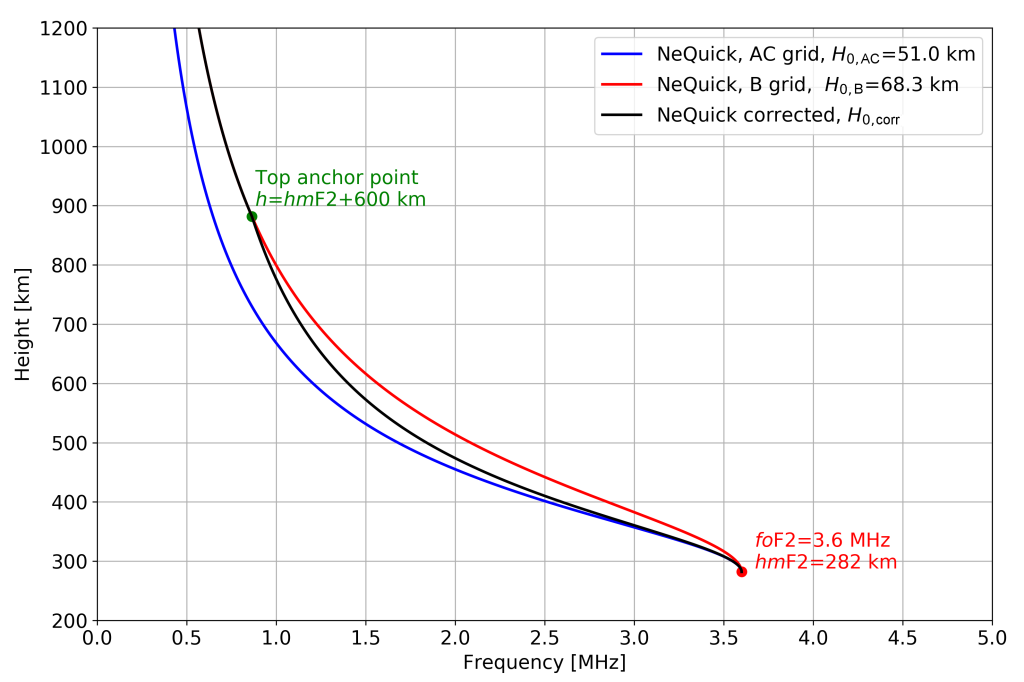
The results show that the proposed formulation is reliable and significantly improves the topside description made by the NeQuick model at mid latitudes, for both high and low solar activities. This means that this new formulation might be proposed as an additional topside option for the International Reference Ionosphere model.
Publication: M. Pezzopane and A. Pignalberi, The ESA Swarm mission to help ionospheric modeling: a new NeQuick topside formulation for mid-latitude regions, Scientific Reports, 9, 12253, 2019. https://doi.org/10.1038/s41598-019-48440-6
Maximum usable frequency and skip distance maps over Italy
Papers from SWICo members
M. Pietrella and M. Pezzopane.
This work describes how MUF and skip distance maps are generated combining the Simplified Ionospheric Regional Model (SIRM) and its UPdated version (SIRMUP) with the Lockwood algorithm. Climatological maps are generated every hour considering the predicted 12-months smoothed sunspots number. Nowcasting maps are instead generated every 15 min exploiting foF2 and M(3000)F2 data measured at the ionospheric stations of Rome and Gibilmanna.
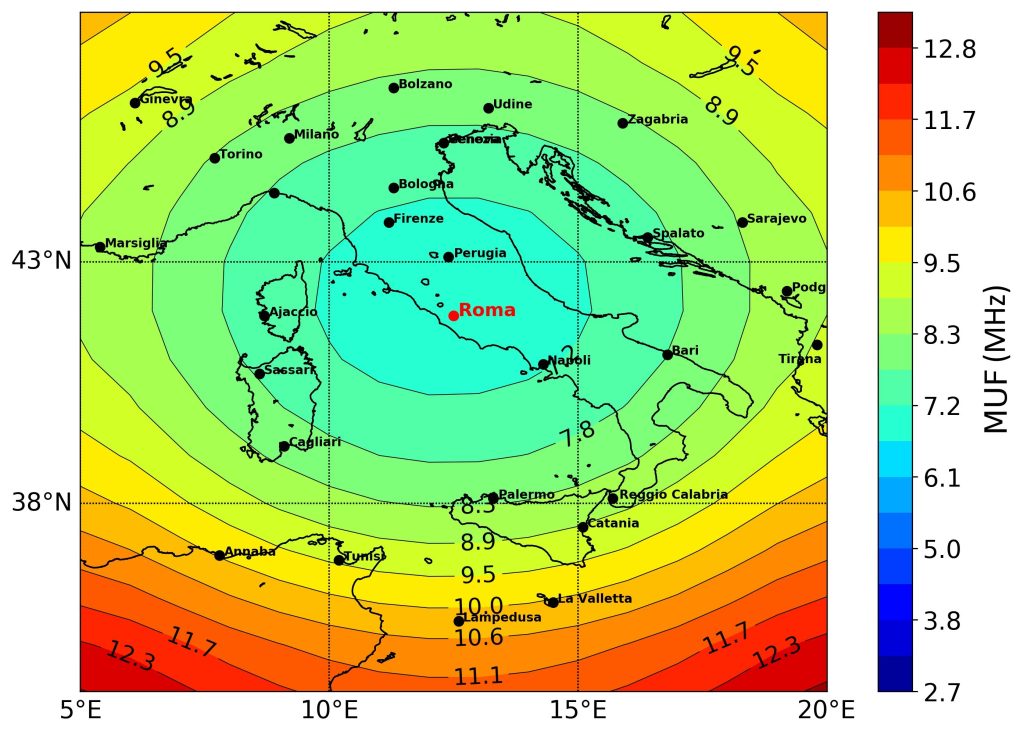
Nowcasting maps constitute the most important novelty because they let High Frequency (HF) users know in quasi real-time the radio propagation conditions over Italy. This is really important in terms of reliable radio links, especially in case of adverse space weather events.
Publication: M. Pietrella and M. Pezzopane, Maximum usable frequency and skip distance maps over Italy, Adv. Space Res., 66(2), 243, 2020. https://doi.org/10.1016/j.asr.2020.03.040
On the identification of coherent structures in space plasmas: the magnetic helicity-PVI method
Papers from SWICo members
F. Pecora, S. Servidio, A. Greco, W. H. Matthaeus
Plasma turbulence can be viewed as a magnetic landscape populated by large- and small-scale coherent structures. In this complex network, large helical magnetic tubes might be separated by small-scale magnetic reconnection events (current sheets). However, the identification of these magnetic structures in a continuous stream of data has always been a challenging task.
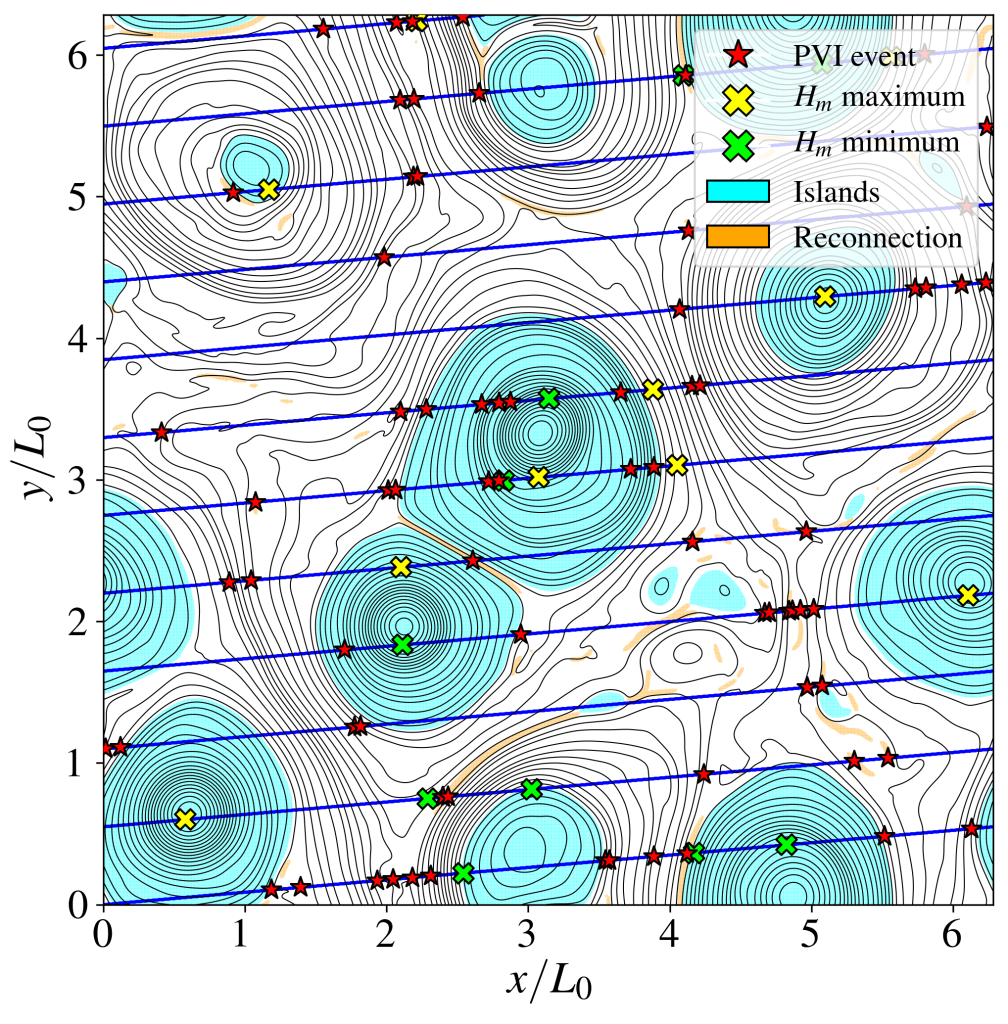
Here we present a method that is able to characterize both the large and small scale structures of the turbulent solar wind, based on the combined use of a filtered magnetic helicity (H_m) and the Partial Variance of Increments (PVI).
This simple, single-spacecraft technique, has been validated first via direct numerical simulations of plasma turbulence and then applied to data from the Parker Solar Probe (PSP) mission.
This novel analysis, combining H_m~PVI methods, reveals that a large number of flux tubes populate the solar wind and continuously merge in contact regions where magnetic reconnection and particle acceleration may occur.
Publication: Pecora F., Servidio S., Greco A., Matthaeus W.~H., 2021, A\&A, 650, A20. doi:10.1051/0004-6361/202039639. https://www.aanda.org/component/article?access=doi&doi=10.1051/0004-6361/202039639
Iniziato il secondo congresso SWICo
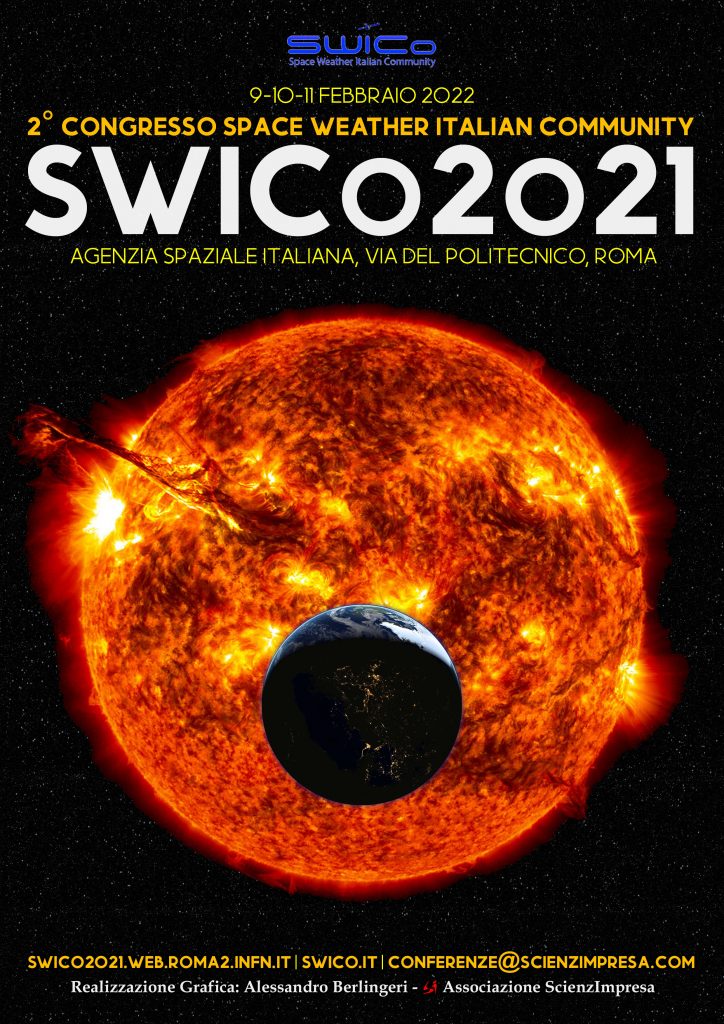
E’ iniziato oggi, 9 febbraio 2022 il “Secondo Congresso Nazionale SWICo” presso la sede ASI di Roma. L’incontro della comunità proseguirà nei giorni 9, 10 e 11 febbraio 2022 (https://swico2021.web.roma2.infn.it/). Il Congresso sarà momento di incontro e confronto dell’intera comunità eliogeofisica italiana impegnata nelle discipline relative allo Space Weather (dal Sole all’interno della Terra). E’ pertanto aperto anche a ricercatori e tecnologi non aderenti a SWICo ed è particolarmente incoraggiata la partecipazione attiva di studenti, dottorandi e giovani ricercatori.
Durante il convegno si terrà anche l’Assemblea Nazionale SWICo per il rinnovo degli Organi Statutari.
Il Congresso offrirà anche l’opportunità del conferimento del Premio “Franco Mariani” (https://swico2021.web.roma2.infn.it/premio-mariani), istituito per onorare la memoria di una personalità scientifica di statura internazionale e rivolto a giovani laureati magistrali in discipline inerenti lo “Space Weather”.
Per ulteriore informazioni sul congresso SWICo raccomandiamo la lettura delle interviste uscite nei giorni scorsi:
https://www.dire.it/07-02-2022/705540-space-weather-il-pericolo-che-viene-dal-sole-%EF%BF%BC/
Quando il Sole fa i capricci

E’ stato recentemente pubblicato un libro divulgativo dedicato allo Space Weather scritto dal Prof. Umberto Villante: Quando il Sole fa i capricci (ed. Dedalo).
Blackout, interruzioni nelle comunicazioni, traffico aereo in tilt, animali e navigatori che perdono la bussola, satelliti fuori uso, pericoli per gli astronauti: le tempeste solari sono sempre esistite, ma oggi il loro impatto sulla nostra società tecnologica può essere devastante. La giovane disciplina denominata space weather, meteorologia spaziale, studia proprio i capricci del Sole e i loro effetti sul nostro pianeta. Villante, tra i massimi esperti del settore, ci guida in modo chiaro e originale nella storia e negli attuali programmi di studio internazionali su queste tematiche, permettendoci di capire a che punto siamo nella comprensione e nella previsione di tali fenomeni. Tra aurore polari, tempeste magnetiche e possibili ripercussioni su milioni di persone, dobbiamo oggi chiederci che tempo farà sul Sole domani.
Course on “Radiation Belt Dynamics and Remote Sensing of the Earth’s Plasmasphere”
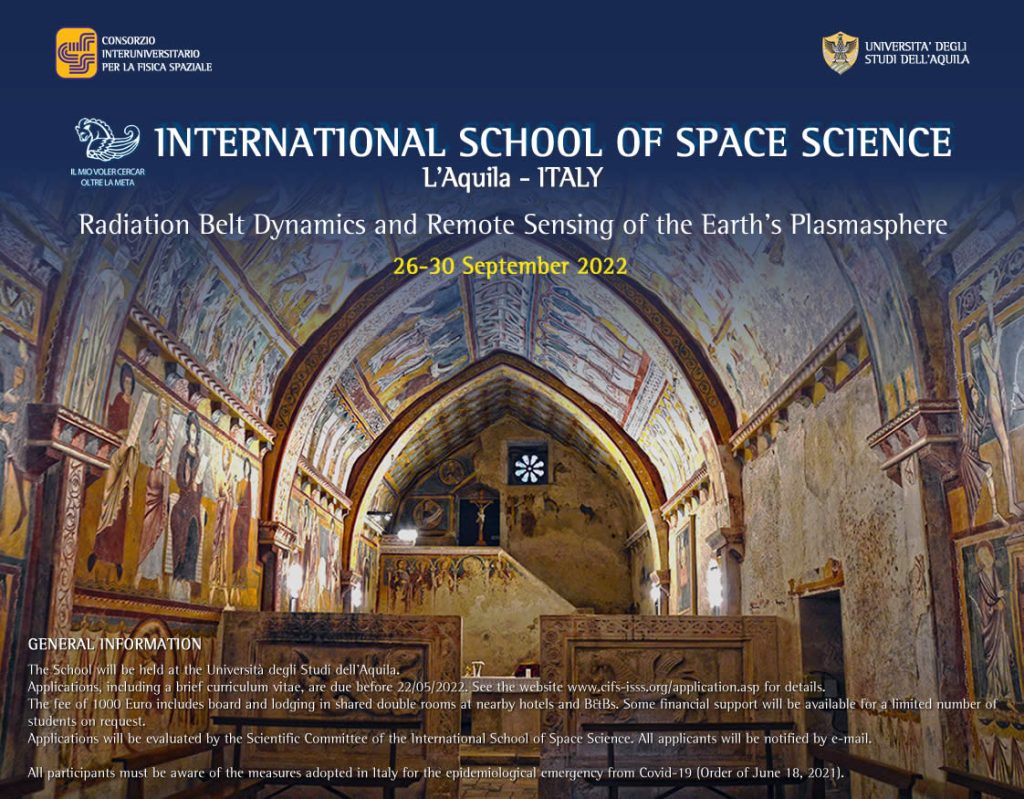
The International School of Space Science of the Consorzio Interuniversitario per la Fisica Spaziale organizes a Course on “Radiation Belt Dynamics and Remote Sensing of the Earth’s Plasmasphere”, to be held in L’Aquila, Italy, 26-30 September, 2022 directed by Prof. János Lichtenberger (Eötvös Loránd University, Budapest, Hungary), Prof. G. Reeves (Los Alamos
National Laboratory, Los Alamos, USA) and Prof. Massimo Vellante (University of L’Aquila, L’Aquila, Italy).
The course is designed for PhD students and young post-doctoral researchers. It will offer an overview of the current knowledge of a key Space Weather region, the radiation belts, and in particular on its related energization and loss processes due to wave-particle interactions, and particle precipitation into the atmosphere. These processes are strongly governed by the properties of the plasmasphere (the outward extension of the ionosphere) which is partially overlapping with the radiation belts. Part of the course will be then devoted to present, both from
a theoretical and observational point of view, as well as through modelling, the basic plasmasphere dynamics, including its coupling with the ionosphere.
Applications are due before May 22, 2022
For more information visit https://www.cifs-isss.org/ or send an e-mail to ssc@aquila.infn.it
Course on “The different spatio-temporal scales of the solar magnetism”
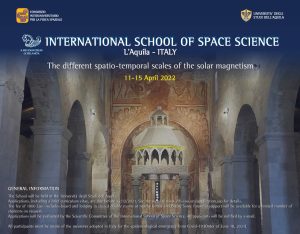
The International School of Space Science of the Consorzio Interuniversitario per la Fisica Spaziale organizes a Course on “The different spatio-temporal scales of the solar magnetism”, to be held in L’Aquila, Italy, 11-15 April, 2022 directed by Prof. F. Zuccarello (Università di Catania, Italy) and Prof. L.Bellot Rubio (Instituto de Astrofisica de Andalucía, IAA-CSIC, Spain).
The School is aimed at providing an in-depth overview of the magnetic phenomena occurring in our star, as well as at presenting some of the most recent tools that can allow to directly tackle the analysis of the problems that are still present in the comprehension of solar magnetic phenomena, through hands-on sessions.
The main topics that will be examined are: the global magnetic field of the Sun and the solar cycle; the small-scale magnetic field: emergence and evolution; the global and local dynamo; the sunspots: processes of formation and evolution and the fine-structure of umbrae and penumbrae; magnetic field instabilities, eruptive events and their impact on Space Weather.
Applications are due before November 21, 2021.
For more information visit https://www.cifs-isss.org/ or send an e-mail to ssc@aquila.infn.it
Magnetic Energy Balance in the Quiet Sun on Supergranular Spatial and Temporal Scales
Papers from SWICo members
F. Giannattasio, G. Consolini, F. Berrilli, and D. Del Moro
Small-scale magnetic fields are ubiquitous in the quiet solar photosphere and may store and transfer huge amounts of energy to the upper atmospheric layers giving rise to a chain of phenomena that are relevant for Space Weather. For this reason, it is fundamental to constrain the energetics of the quiet Sun.
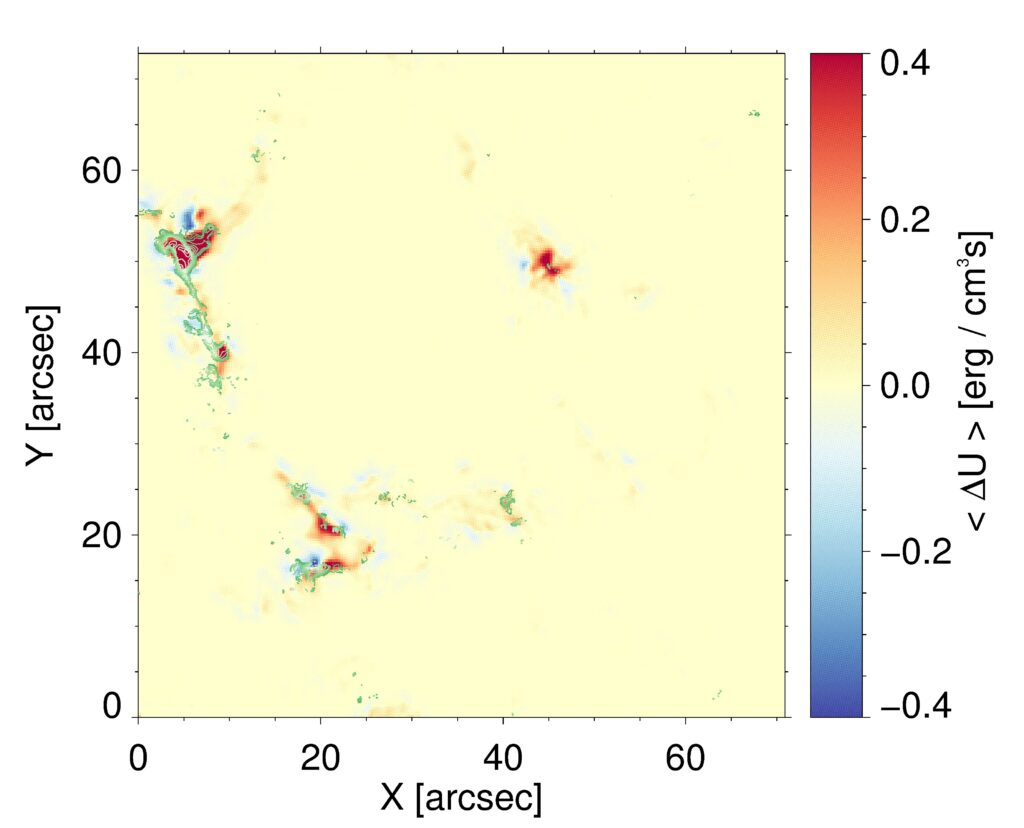
By taking advantage of a 24 hr long with 90 s cadence magnetogram time series acquired by the Hinode mission without interruption, we computed, for the first time, the average photospheric electric field, the average current density, and starting from these, the rate of change of magnetic energy density on supergranular spatial and temporal scales. The main result is that, on average, the energy provided by photospheric electric and magnetic fields and current density can sustain the magnetic fields in the network.
Publication: F. Giannattasio, G. Consolini, F. Berrilli, and D. Del Moro, Magnetic Energy Balance in the Quiet Sun on Supergranular Spatial and Temporal Scales, The Astrophysical Journal, 904, 1, 2020.
https://doi.org/10.3847/1538-4357/abbb36
Multiscale Analysis of the Turbulent Ionospheric Medium
Papers from SWICo members
P. De Michelis and R. Tozzi
The physical parameters which describe many fluid and plasma systems, such as density, velocity, temperature, and electric and magnetic fields, are often characterized by fluctuating values. When the fluctuations are observed over many spatial and temporal scales and a nonlinear transfer of energy occurs between the different scales, the system is generally said to be in a turbulent state. Several interplanetary space environments, such as solar wind, ion foreshock, the magnetosheath, and the magnetotail and, last but not least, the ionosphere, have been found to be in a turbulent state.
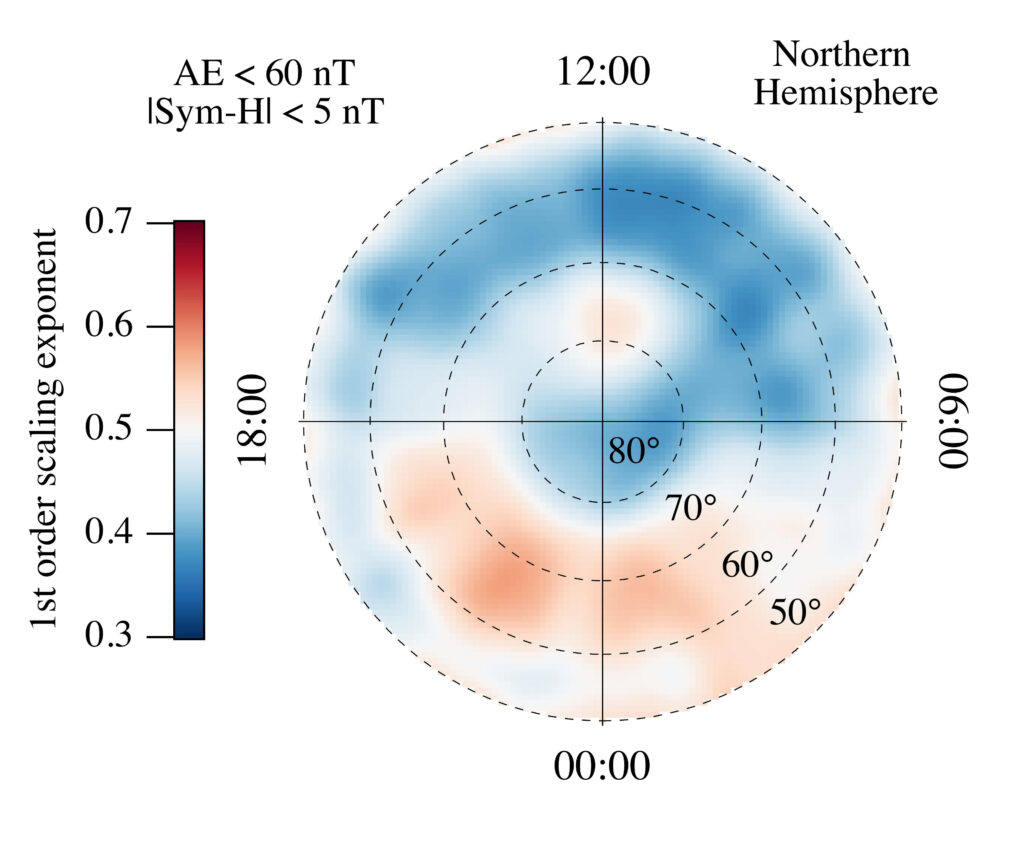
Turbulence crucially influences the cross-scale coupling of the dynamical processes: it can influence the transport of mass, momentum, and energy from solar wind and the magnetosphere to the ionosphere and can also perturb the equilibrium structure of the ionosphere, as well as the plasma dynamics and particle energization at many locations in the ionosphere. Here, we review some recent findings on the multiscale and turbulent character of the ionosphere, with a special emphasis on high-latitudes. In particular, we analyse some scaling features of magnetic field fluctuations, relating them to their spectral properties and the occurrence of intermittency phenomena.
Publication: P. De Michelis and R. Tozzi, “Multiscale Analysis of the Turbulent Ionospheric Medium”, Chapter 19 in “The Dynamical Ionosphere”, Editors: M. Materassi, B. Forte, A. Coster and S. Skone, Elsevier 2020.
https://doi.org/10.1016/B978-0-12-814782-5.00019-4
Detection Capability of Flux Ropes during the Solar Orbiter Mission
Papers from SWICo members
Telloni, Daniele; D’Amicis, Raffaella; Bruno, Roberto; Carbone, Francesco; Perrone, Denise; Zank, Gary P.; Zhao, Lingling; Nakanotani, Masaru; Adhikari, Laxman
Flux ropes are interplanetary magnetic helical structures that are receiving increasing attention because of their likely role in magnetohydrodynamic (MHD) processes as well as their impact on space weather science. A very promising and powerful approach to address their investigation and characterization is based on wavelet spectrograms of the invariants of the ideal MHD equations.
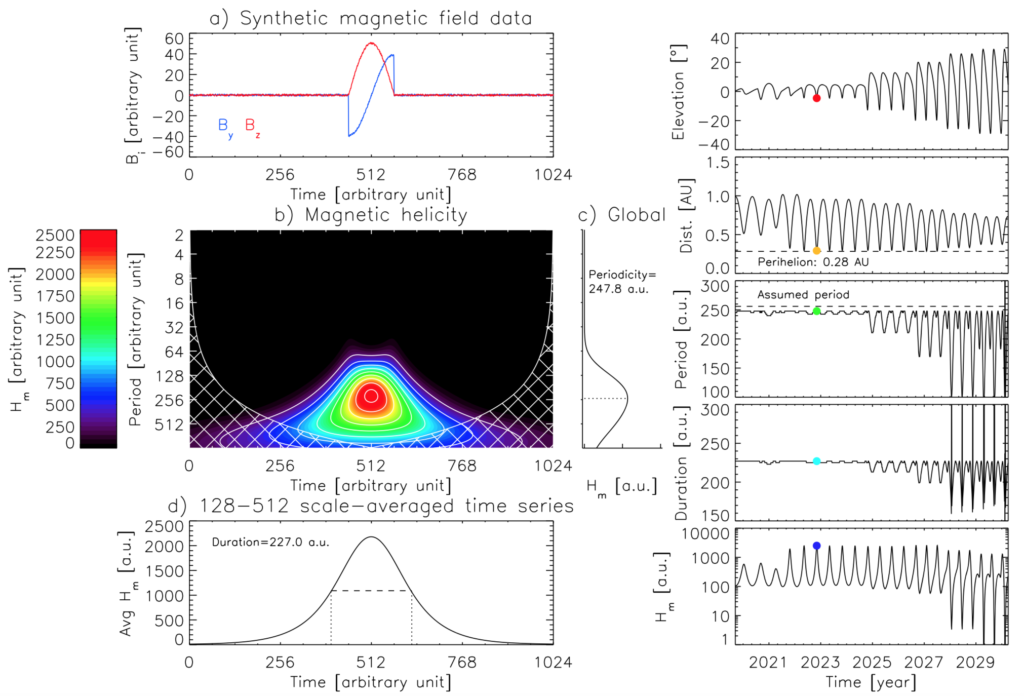
The accuracy of this method to infer flux rope properties depends on the proper evaluation of the direction of propagation of the flux rope itself, which is often difficult to assess. We present a numerical test of the reliability of this diagnostic technique, by simulating a synthetic flux rope of fixed size and propagation direction along the Solar Orbiter orbit, that is very elongated and inclined with respect to the orbital plane. We find that when the flux rope is crossed for less than 50% of its width, the procedure becomes unreliable. Quantitative information on how to properly recover the flux-rope intrinsic properties is provided.
Publication: Telloni D., D’Amicis R., Bruno R., Carbone F., Perrone D., Zank G. P., Zhao L., et al., 2020, ApJL, 899, L25.
https://iopscience.iop.org/article/10.3847/2041-8213/abacc4




